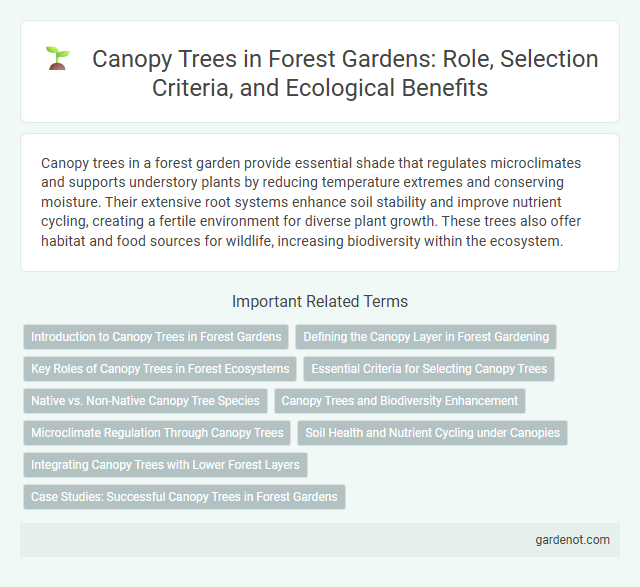Canopy trees in a forest garden provide essential shade that regulates microclimates and supports understory plants by reducing temperature extremes and conserving moisture. Their extensive root systems enhance soil stability and improve nutrient cycling, creating a fertile environment for diverse plant growth. These trees also offer habitat and food sources for wildlife, increasing biodiversity within the ecosystem.
Introduction to Canopy Trees in Forest Gardens
Canopy trees form the uppermost layer in forest gardens, providing essential shade and microclimate regulation for understory plants, which enhances biodiversity and soil health. Common species include oak, maple, and chestnut, selected for their longevity, dense foliage, and fruit or nut production that supports wildlife and human use. Their deep root systems improve soil structure and water retention, making canopy trees a crucial element for sustainable forest garden ecosystems.
Defining the Canopy Layer in Forest Gardening
The canopy tree in forest gardening forms the uppermost layer, creating essential shade and microclimate conditions that support diverse plant species below. These tall, often fruit- or nut-bearing trees optimize sunlight interception while protecting understory plants from harsh weather, promoting biodiversity and soil health. Selecting native or well-adapted canopy species ensures sustainable nutrient cycling and enhances overall ecosystem resilience within the forest garden.
Key Roles of Canopy Trees in Forest Ecosystems
Canopy trees play a critical role in forest ecosystems by regulating microclimates, providing essential habitat and food sources for diverse wildlife species, and facilitating nutrient cycling through leaf litter decomposition. Their extensive root systems stabilize soil and help prevent erosion, while their tall stature allows them to intercept sunlight, supporting understorey vegetation growth by creating filtered light conditions. Canopy trees also contribute to carbon sequestration, significantly mitigating climate change impacts by absorbing substantial amounts of atmospheric CO2.
Essential Criteria for Selecting Canopy Trees
Ideal canopy trees for forest gardens must exhibit strong structural integrity, deep root systems for nutrient uptake, and high resilience to local climate conditions to ensure long-term stability. Selecting species with rapid growth rates, nitrogen-fixing capabilities, and compatibility with understory plants enhances ecosystem productivity and biodiversity. Prioritize native or well-adapted trees that provide shade, support pollinators, and contribute to soil health for a thriving forest garden canopy.
Native vs. Non-Native Canopy Tree Species
Native canopy tree species play a crucial role in forest gardens by supporting local biodiversity, enhancing soil health, and providing habitat for native wildlife. Non-native canopy trees may offer rapid growth or unique aesthetic qualities but often risk invasive behavior and can disrupt the ecological balance of forest gardens. Selecting native species like oak, maple, and hickory ensures ecosystem resilience and long-term sustainability in managed forest environments.
Canopy Trees and Biodiversity Enhancement
Canopy trees play a crucial role in forest gardens by providing essential habitats that boost biodiversity through shelter and food sources for various species. Their expansive foliage regulates microclimates, promoting understorey growth and supporting diverse plant and animal communities. Incorporating native canopy trees enhances ecological resilience and sustains pollinators and wildlife within the garden ecosystem.
Microclimate Regulation Through Canopy Trees
Canopy trees play a crucial role in microclimate regulation within forest gardens by providing shade that reduces ground temperature and limits soil moisture evaporation. Their dense foliage acts as a natural barrier against wind, helping to maintain stable humidity levels and protect understory plants. By moderating temperature fluctuations and enhancing moisture retention, canopy trees create a favorable environment for diverse plant growth and increased biodiversity.
Soil Health and Nutrient Cycling under Canopies
Canopy trees in forest gardens play a critical role in enhancing soil health by promoting nutrient cycling through leaf litter decomposition and root activity. Their extensive root systems improve soil structure, increase microbial diversity, and facilitate the uptake of nutrients, which supports understory plants. This natural nutrient cycling under canopies reduces the need for external fertilizers and sustains long-term soil fertility.
Integrating Canopy Trees with Lower Forest Layers
Integrating canopy trees with lower forest layers enhances biodiversity, promotes nutrient cycling, and stabilizes microclimates within forest gardens. Species like oak (Quercus spp.) and walnut (Juglans spp.) form dominant upper layers that provide shade and organic matter, supporting mid-story shrubs and herbaceous plants. This vertical stratification optimizes sunlight capture, improves soil health, and creates habitat connectivity crucial for sustainable agroforestry systems.
Case Studies: Successful Canopy Trees in Forest Gardens
Case studies of successful canopy trees in forest gardens highlight species like the Black Walnut (Juglans nigra), known for its valuable timber and edible nuts, which also improves soil fertility through nitrogen fixation. The Oak (Quercus spp.) demonstrates resilience and supports biodiversity by providing habitat and food for wildlife, thus enhancing ecosystem services in forest gardens. Incorporating these canopy trees promotes sustainable agroforestry systems that optimize space, productivity, and environmental benefits.
Canopy tree Infographic

 gardenot.com
gardenot.com